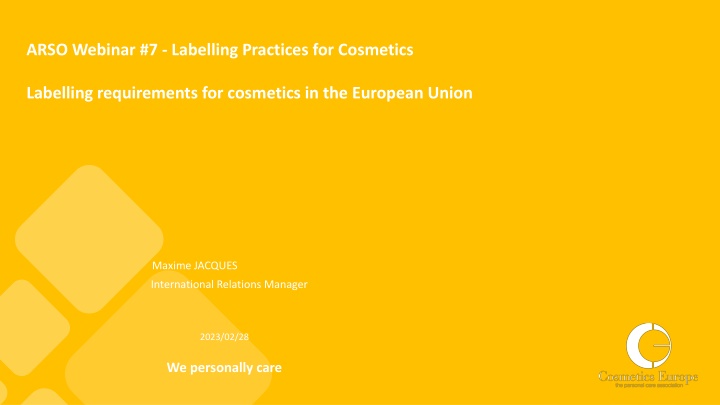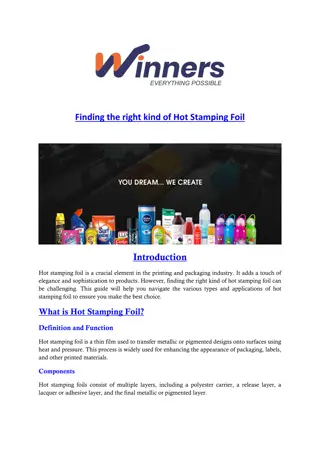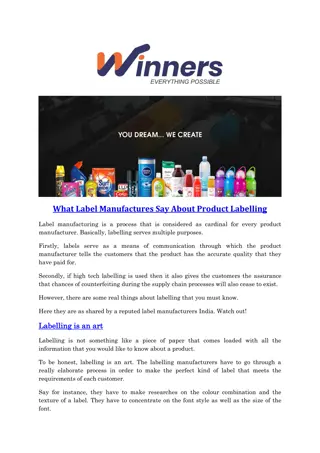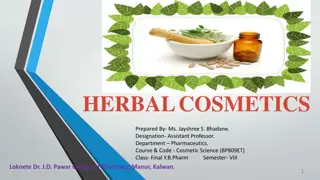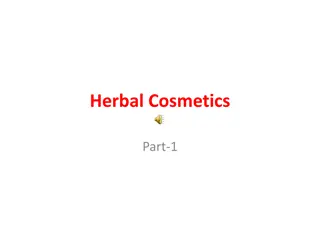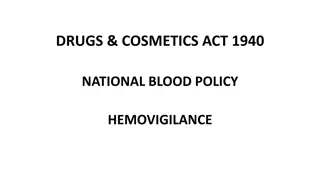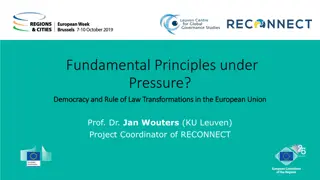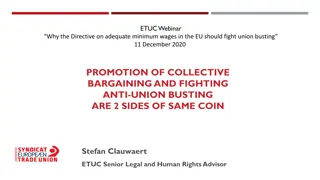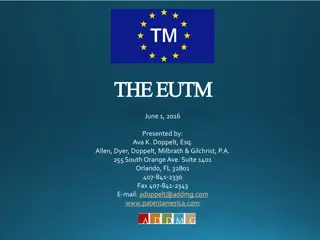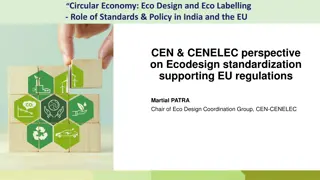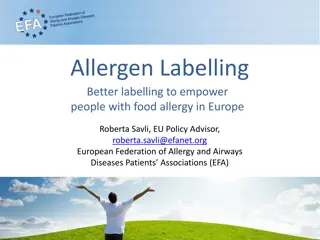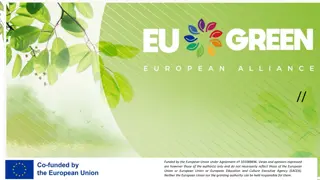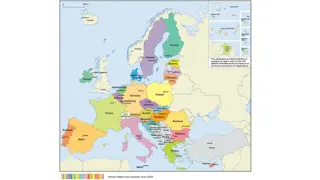Labelling Practices for Cosmetics in the European Union
Explore the labelling requirements for cosmetics in the European Union, focusing on the essential principles and mandatory information. Understand the role of the Responsible Person in ensuring compliance and learn how to provide key information to consumers for safe usage. Dive into the world of cosmetic regulations and industry standards with insights from Cosmetics Europe.
Download Presentation

Please find below an Image/Link to download the presentation.
The content on the website is provided AS IS for your information and personal use only. It may not be sold, licensed, or shared on other websites without obtaining consent from the author.If you encounter any issues during the download, it is possible that the publisher has removed the file from their server.
You are allowed to download the files provided on this website for personal or commercial use, subject to the condition that they are used lawfully. All files are the property of their respective owners.
The content on the website is provided AS IS for your information and personal use only. It may not be sold, licensed, or shared on other websites without obtaining consent from the author.
E N D
Presentation Transcript
ARSO Webinar #7 - Labelling Practices for Cosmetics Labelling requirements for cosmetics in the European Union Maxime JACQUES International Relations Manager 2023/02/28 We personally care We personally care
Europe is one of the global flagship producer of cosmetic products around the world (> 80B in 2021), offering a mature and detailed cosmetic regulation, globally recognized, since more that 40 years. Cosmetics Europe (CE) is the European trade association for the cosmetics and personal care industry since 1962 Our members include cosmetics and personal care manufacturers as well as associations representing our industry at national level. Thousands of big and small companies, right across Europe CE is the main industry contact for the EU Institutions on regulatory issues regarding cosmetics. We personally care www.cosmeticseurope.eu
Overall principles The European cosmetic framework, as well as every cosmetic scheme around the world, is aiming for the same objective: the deliverance of Safe, high Quality and Effective personal care products to consumer With the careful selection of the ingredients used, and the safety assessment of the finished product, labelling is the third pilar of product s safety What is the function of the product? How should I use it? What effect can I expect? What is in its composition? How long can I use it, or when does it expire? Where does it come from? Who is responsible of the compliance of this product? How can we identify it throughout the distribution chain? The label of the product should: provide key information to consumers on how to safely use the product, and what effect to expect Enable authorities to identify and track the product, to identify who is responsible, as well as to perform the first level of compliance check of the product We personally care
Mandatory information We personally care We personally care
Name and address of the RP The Responsible Person can be a natural person (i.e., an individual) or legal entity (i.e., a company) that is responsible for the compliance of the product with the relevant obligations set out in the Cosmetics Regulation Essential to facilitate the identification of the RP by the control authority for further investigation on the product As part of its duties, the RP must ensure that the Product Information File is accessible at the address mentioned on the pack Name of the RP should be the Single Contact Point of compliance and responsibility of the product for the authority name of other actors of the supply chain (such as the name of the outsourced manufacturer...) is not relevant information at the point of sale + is sensitive business Intellectual Property information We personally care
Country of Origin Only required for products manufactured in third countries and imported in the EU Nominal content The nominal quantities are expressed in units of weight or volume except in specific cases ( small products ) We personally care
Minimum durability or PAO? Any cosmetic product that has a lifespan of less than 30 months must show a Best before mention, or an egg timer symbol , followed a date than can be easily understood Products with a lifespan longer than 30 months, cosmetic products must show a Period After Opening" time, meaning the time in months or year when the product will remain in good condition after the consumer has used the product for the first time 12M Further guidelines on the practical implementation of the PAO are available on the EU Commission website: https://ec.europa.eu/docsroom/documents/13040?locale=en We personally care
List of ingredients List of ingredients shall be preceded by the term INGREDIENTS Ingredients should be listed in descending order of concentration in the product Ingredients must be expressed using the common ingredients name set out in the glossary (update March 2022) The EU glossary is regularly updated to integrate the progressive updates of the INCI nomenclature INGREDIENTS Aqua, Cyclomethicone, Mica, Polybutene, Trisosteann, Prunus Persica Flower Extract, Betula Alba Oil, Lavandula Officinalis Oil, Paraffinum Liquidum, Propylene Carbonate, Methylparaben, Phenoxyethanol, Propylparaben, Lecithin, Alcohol Denat., BHT, Parfum, Aroma, Cinnamyl Alcohol, Citronellol, [+/- CI 15580, CI 45430] Perfume mixtures are labelled as PARFUM , and for flavours such as in toothpaste, may be listed as AROMA , except for certain specific perfume/aroma ingredients (allergens) if present above 10ppm in leave on / above 100ppm in rinsed-off products, as identified in annexe III Colours use the Colour Index Number, or CI Number, an international naming system the mention may contain or the symbol +/- can be used for decorative cosmetics existing in different colour shades sharing a common ingredient list We personally care
Warnings/precautions for use Product labelling shall carry relevant warnings that might be necessary on how to use the product safely: Instructions, for example: Use the product once/twice a week Particular rituals, combination of several skin/hair care products ... Precautions, for example: The need to conduct an allergy alert testing before use of the product (hair products) avoid contact with the eyes for external parts of the body only Instruction in case of contact with non-intended areas ... Precautions either imposed for substances of Annex III, or by the safety assessor following the assessment of the product We personally care
Batch number The batch number (or batch reference) enables to identify and trace out the manufactured cosmetic product and its compounds all along the supply chain Essential in case of issue: - when you have to trace out all the stakeholders that entered in contact with the product - In case of product recall - In case of serious adverse effect experienced by a consumer The Regulation does not specify the format for the batch number = internal code chosen by the RP We personally care
Where should the information be labelled? We personally care We personally care
Information available on the container and packaging of cosmetic products Most of the information must be made available to the consumer at the point of sale to allow informed decision making o What is the function of the product? What is the composition? Where does it come from? What is the lifespan? cosmetic products [shall] bear the following information in indelible, easily legible and visible lettering (Art. 19) o The information can be printed on the pack or provided via over-stickering important for international product Products with a container only Name and address of the RP Country of origin (if non-EU) Nominal content Minimum durability or PAO Precautions of use Batch number (product s function, if not clear) Ingredient list in INCI No labelling of marketing authorisation Possibility to provide the information via a sticker We personally care
Information available on the container and packaging of cosmetic products Most of the information must be made available to the consumer at the point of sale to allow informed decision making o What is the function of the product? What is the composition? Where does it come from? What is the lifespan? cosmetic products [shall] bear the following information in indelible, easily legible and visible lettering (Art. 19) o The information can be printed on the pack or provided via over-stickering important for international product Products with inner and outer packaging Name and address of the RP Country of origin (if non-EU) Nominal content Minimum durability or PAO Precautions of use Batch number (product s function, if not clear) Ingredient list in INCI No labelling of marketing authorisation Possibility to provide the information via a sticker We personally care
Exemption for small packaging 5g or 5mL If impossible for practical reasons to label the information on the product, the information shall be mentioned on an enclosed or attached leaflet, label, tape, tag or card, or in last resort, on a notice in immediate proximity at the point of sale this information shall be referred to by abbreviated information or the symbol Products <5g or 5mL, or impracticable reasons Name and address of the RP Country of origin (if non-EU) Nominal content or Minimum durability or PAO Precautions of use Batch number Lipstick 4g (product s function, if not clear) Ingredient list in INCI No labelling of marketing authorisation Possibility to provide the information via a sticker We personally care
Regulatory enforcement We personally care We personally care
In-market control Inspection of the label is the first step of in market control In picking-up product directly from the market, the authority can easily conduct the first step of the inspection process and assess whether the product is compliant with labelling (and safety) requirements This assessment can give a good signal about the trustworthyness of a Responsible Person, and trigger further inspection if needed, in contacting the name of the RP mentioned on it. Name and address of the RP Country of origin (if non-EU) Nominal content Key information for the control authority and anti- poison control centres Minimum durability or PAO Precautions of use Batch number (in case of pb) Key information for safe use by the consumer (product s function, if not clear) compliance check on the market Ingredient list in INCI We personally care
Benefit of following global Best Labelling Practices around the world Region-specific labelling requirements means market fragmentation and additional cost that not every company is able to bear Uniformity of the requirements favours greater circulation of the goods, fruitful trade and therefore growth of the sector Diverging labelling requirements puts pressure on the packaging that must carry more and more information... in the age of environmental awareness and commitment against packaging waste Uniformity of the requirements enables efficient and essential communication on a minimum of packaging What EU shows, is that even in a region with 27 countries and 24 languages, it is possible to harmonize labelling practices and remove labelling as a barrier to trade Common labelling practices means international compliance, global market access and common safety and quality principles We personally care
Additional resource Cosmetics Europe Guidelines on Cosmetic Product Labelling (2011) https://cosmeticseurope.eu/files/8814/6407/5369/Guidelines_on_Cosmetic_Product_Labelling_-_2011.pdf We personally care
